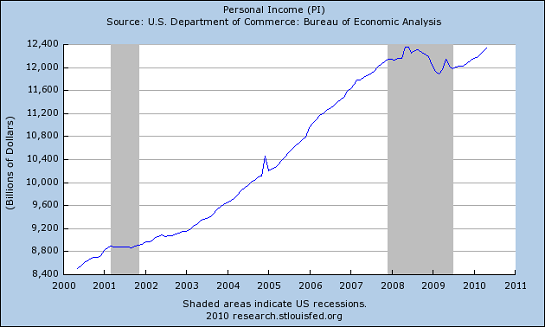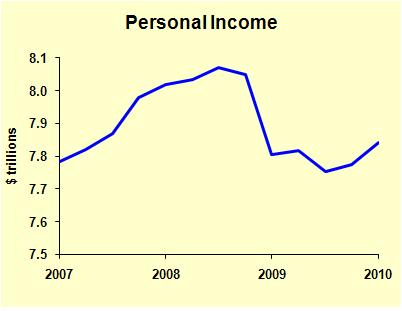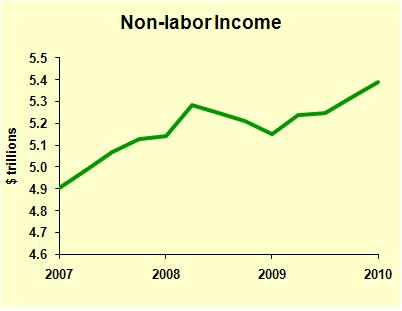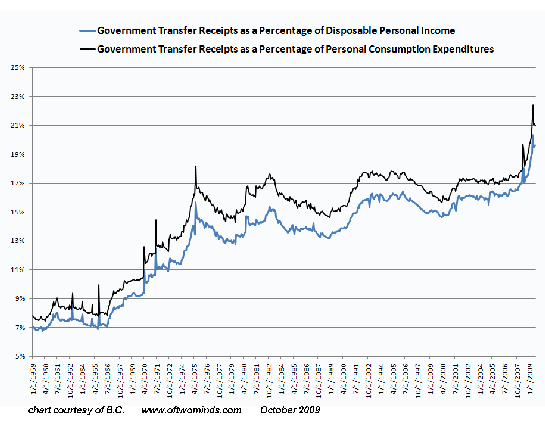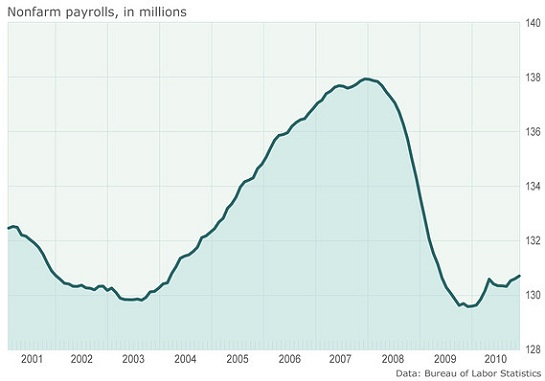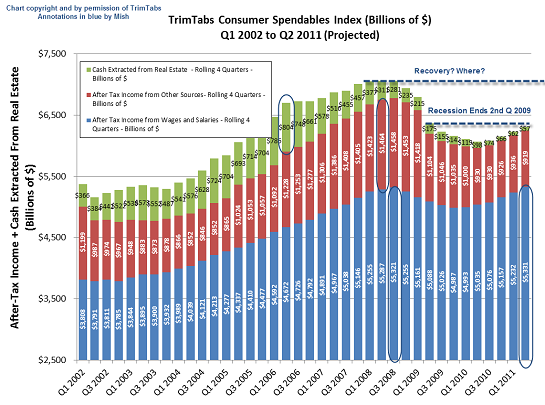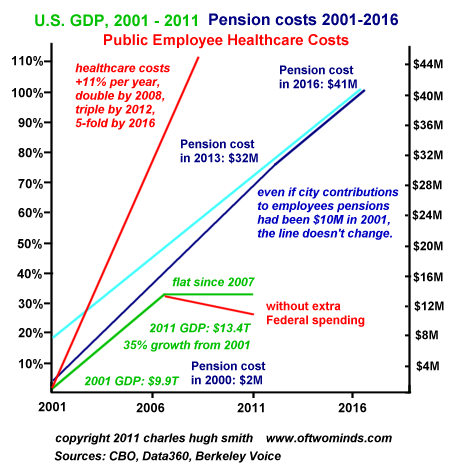This is a contributing European CDS trader's commentary on the BoomBustBlog research piece "Is Another Banking Crisis Inevitable?".
At this stage i have a remark/question in your « the inevitability of a banking crisis »(dated when?) you were waaay too optimistic (!!) seeing 172bn of losses related to PIIGS. We may be over that only on Greece exposure!
Certainly, if we compare the fiscal trajectory of the Eurozone as a whole with the US, the US is not really on a better path. Austerity has started in Europe. US seems still in full spending spree.
I would argue as long as there is no bank run and voluntary secession, things even if shaky, will stay more on less under control by governments. Being anti-Euro can win elections, and there is a real chance that some country (Greece, Finland...) quit the Euro by themselves for not wanting austerity or not wanting to bail out other countries. But so far, its just talk. In Portugal they voted out the PM, well they still got austerity...Ireland is a total joke as well.
So if we step back, and ask ourselves who's going to buy this ever growing govt debt, well this is the banks of course !
Look (I didnt!) at the balance sheet of Japanese banks 20 years ago and now, many JGBs in their balance sheet, in place of those turned sour (real estate) loans...every $ or euro spent from the budget, ends up in a bank account, and the ALM officer of that bank, well, the only stuff he can buy with it, is a govt bond as its the only « safe » asset (what else would be ? Even if they bought all those google bonds...)
Well, if you take a look at how well that technique turned out for the Japanese banks, a widespread, long term bear trade on the banks may not be that bad an idea, despite how obvious the trade may be!
.. It is the reporting company’s responsibility to report, not to obfuscate. The big problem with this “hide the market marks” thing is that markets tend to revert to mean. Unless said market values fundamentally catch up with said market prices, you will get a snapback. That is what is happening in residential real estate now. That is what happened in Japan over the last 21 years!!! That’s right, it wasn’t a lost decade in Japan, it was a lost 2.1 decades!
This has been the first balance sheet recession that the US has ever had, but there is precedence to follow. Japan had a balance sheet recession following their gigantic real asset bust. They made a slew of fiscal and policy errors, which essentially prolonged their real asset recession (now officially a depression) for T-W-E-N-T-Y O-N-E long years! For those that may have a problem reading that, it is 21 long years. What did the Japanese do wrong?
- They refused to mark assets to market
- They attempted to prop up zombie banks
- They failed to promptly clean up NPAs in the banking system
- They looked the other way in regards to real estate value shenanigans
Now, for those of you who believe that the government's "pretend and extend" policy has any chance in hell of working, or better yet, that we are not following in the footsteps of Japan, let's take a pictorial trip through recent history. There are nearly no Japanese banks in the top 20 bank category on a global basis by 2003 – NONE (save potentially Nomura, which arguably survived in name, alone). As you can see, they literally dominated 90% of the space in 1990!
Click to enlarge…
top_20_banks.jpg
... and well if the ALM officer doesnt buy those bonds, and buys something else, the money just ends up in another bank which will buy those bonds !
The system is full circle...there is no flaw as long as people keep their money in the bank.
I have always been of the contention that the 2008 market crash was cut short by the global machinations of a cadre of central bankers intent on somehow rewriting the rules of economics, investment physics and global finance. They became the buyers of last resort, then consequently the buyers of only resort while at the same time flooding the world with liquidity and guarantees. These central bankers and the countries they allegedly strive to serve took on the debt and nigh worthless assets of the private sector who threw prudence through the window during the “Peak” phase of the circle of economic life, and engaged in rampant speculation. Click to enlarge to print quality…
In the worst case, banks leave their money in the Central bank which will underwrite bonds.
Thats also why Greek bonds being eligible to the ECB is a key political issue. As long as they are, the ECB can provide money against those bonds... Govts havent printed money directly so far (if they did, no more need to issue bonds, just issue money with no interest...), just bonds that can be repo-ed to the CB and thats really when money is created.
Doomsayers have been saying for 10-15 years that the Japanese financial system would collapse, well the game is still on, and could last another 10-15 years (or more, or less, i dont know !). To me its really a game of confidence. Indeed, if there was a real Greek default and bank runs, then it would sure have a strong impact on the public, and we could have a chain reaction, and thats what i think the European politicians want to avoid #1. cause if they can, the zombified financial system can muddle through for years.
Yes, but as you can see from the charts and graphs above, the kick the can methodology or reality rendering didn't necessary work that well for real asset pricing or Japanese bank global presence, valuation or competitiveness.
So where does this leave valuations and the European banking system ?
Well, on one hand we have this insolvent system, that tries to survive. But there are institutions too weak to be saved.
Bank of Ireland, RBS, … show the way... well end up having more and more govt participation and regulation. In some countries, the whole financial sector might end up being nationalized. Financial sector is dead. It used to be 10%-15% of the equity market capitalization, went up to nearly 40%-45%. on that metric alone, there is much room for downside (perhaps another 50% with the same level in the broad index). Basel III, even if its not enforced yet (and perhaps by the time it should there wont be many private banks left in Europe...), gives a clear message: banks need to raise a lot of equity. And that needs a discount as many banks need this money, the new business model will be less profitable because of less leverage. Banks will try to hike fees, and merge to save costs.
Maybe if we see some spectacular failures, we will see a big transformation, especially with new entrants focusing just on deposits and payments. In Europe, banks are « universal » you tend have your account, your credit card your mortgage, your car loan, your brokerage account with the same institution. In my opinion it would make a lot of sense for Carrefour (for example) to open a banking operation.
Or enter Glass-Steagal - Euro edition!!!
Because of this increase for competition and diminished returns (less demand for loans)... the only « business » which will be growing in banks, will probably, their ALM !! Where they will buy more and more govt bonds (and BASEL III makes sure their risk weightings are 0% and that they have to do so for their « liquidity coverage ratios » (LCR) so they favour those bonds. This will push yields down, and bank profits down as they have to buy more and more of those bonds to try to keep the same profits. EFSF or any kind of Euro bond would definitely be bought with no problem.
And here we go again! What happens when assets held as risk free (zero risk captial weighting) at 30x to 60x levereage are truly nothing of the sort. This exacly how a tiny economic entity such as Greece (whose economy is probably smaller than that of Brooklyn, and definitely smaller than that of the NY metro area) has managed to gut the entire banking system of a plethora of 17 separate countries and much of the continent. Reference:
- Lies, Damn Lies, and Sovereign Truths: Why the Euro is Destined to Collapse!
- Ovebanked, Underfunded, and Overly Optimistic: The New Face of Sovereign Europe
- and finally How Greece Killed Its Own Banks!
With govt yield downs the extend and pretend game can last for many more years.
That wouldnt prevent banking stocks to go further downhill, as it was the case in Japan, but it might not be a one-way street, and peripheral banks are not necessarily the ones who would suffer most from here in the long run (after all if the crisis is resolved, their underwater govt bonds will be reboosted). And both you and I know that banks know how to twist and inflate their accounting, and that theyre showing profits on what really are losses...
No!!!!! Say it ain't so!
Perhaps another nice short would be the insurance industry.
They might be hurt even more than banks, especially life insurers... especially it has benefited (in France) of a lot of tax rebates / subsidies, which enticed the public into it, and if there is a sovereign accident, I can smell a run there. (I myself cancelled my life insurance, and all the « smart » people around me did so as well.)
All in all, I think it was a great call so far to foresee the European debt mess. But I think its much more tricky for here to make bets. Even the EURUSD trade which looked as a no-brainer at the start of 2011 given how dire the situation was, proved to be much of a pain...( to be honest, I lost myself quite a lot on that one). that should be a warning signal to me that things arent that simple.


